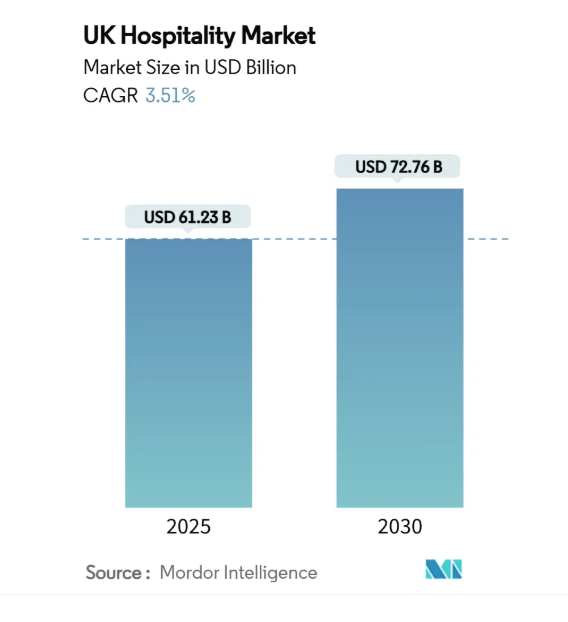Topics: Finance & Accounting, Hospitality Accounting
Posted on September 03, 2025
Written By Priyanka Rout

Walk into a seaside town this summer and the picture looks bright: hotels are booked out, restaurants have waiting lists, and attractions are heaving with visitors. On the surface, you’d expect businesses to be hiring in droves. After all, domestic tourism is booming — 68.6 million day visits in April 2025, up 10%, with spend climbing to £48.4 billion (+6%).

But behind the scenes, the numbers tell a different story. Hospitality shed 22,369 vacancies in June compared with last year, a 25% drop. Since the Budget, the sector has shouldered 53% of all UK job losses, nearly 89,000 roles gone.
For executives, this paradox runs deeper than headcount. Why is a sector that’s serving more customers than ever choosing to shrink its workforce? Is this the fallout of policy and tax changes, the quiet advance of automation, or a structural reset in how hospitality now runs? The answer is layered and that’s what this blog sets out to unpack.
Normally, the story after summer is simple: the season ends, and businesses hire again to gear up for autumn and the Christmas rush. Not this year.
That’s not a slowdown. That’s a brake slam.
And the shape of hiring is changing too:
So what does that tell us? Right now, it looks like businesses are trading certainty for flexibility. It works in the short run – less risk, lower commitments. But over time, the sector could find itself running on a thinner pipeline of talent. Fewer permanent hires today mean fewer supervisors and managers tomorrow. And that’s the quiet cost hiding behind those vacancy numbers.
It raises a bigger question: if hospitality’s future workforce is built on contracts and casual hires, what happens to stability, loyalty, and service quality?
Then add in:
Suddenly every hire looks risky. Expensive. Maybe even unaffordable.
And here’s another twist:
This isn’t a pause on hiring. It’s a workforce redesign.
Not every part of the sector is feeling it the same way.
By sector:
The closer you are to discretionary spending and seasonal swings, the sharper the cuts. That’s the pattern.
💡 Insight: This isn’t just fewer job ads. It is three forces colliding: higher costs, new staffing models, and uneven regional resilience, all redrawing hospitality’s employment map.
Hospitality has always been the “first job” sector. The place where young workers cut their teeth. Where careers are born.
But if that first step isn’t there, the whole ladder starts to wobble.
And the cost? A thinner pipeline of skilled, loyal people. Exactly the thing the industry will be crying out for in a few years’ time.
Picture peak season:
Guests don’t forget that. They talk about it. They post about it. And when they do, no marketing budget in the world can fix the damage.
Saving margin today is one thing. Losing market share tomorrow is another.
Retention and upskilling are the buzzwords right now. Get more out of the people you already have. Hold on tight to experience.
At the same time:
But waiting carries its own risk. Demand won’t wait. Competitors won’t wait. When recovery comes, will the sector be ready?
Hospitality used to be the easy first step into work. A summer job. A weekend shift. A way to get a foot on the ladder. That is no longer guaranteed. With fewer vacancies on offer, the competition is tougher, and the nature of the roles themselves is shifting.
The result? For job seekers, hospitality is not closing its doors, it is changing the locks. The sector is rewarding flexibility and tech confidence while leaving those without it at risk of being shut out of what was once the UK’s most accessible entry point to work.
Winter will be the first real test. Christmas markets, ski travel, and city breaks usually bring a seasonal hiring bump. Operators may bring in extra staff if demand holds up.
But most of these roles are unlikely to be secure, full-time positions. They will be casual shifts, temporary contracts, and seasonal cover. The industry is still cautious, filling gaps without committing to long-term payroll.
Looking further ahead, the shape of the workforce could change permanently. Signs already point to a leaner model: fewer permanent staff, greater reliance on tech, and a heavier use of flexible labour.
Not every operator will face this equally.
This divide may reshape the sector, widening the gap between premium players and mass-market operators.
Government policy could change the picture. Relief on VAT or NICs would create breathing space for businesses to rehire and reinvest. At the moment, speculation around the November Budget leans in the other direction, with talk of further tax rises keeping executives cautious.
That leaves many businesses waiting. Investments are on hold, hiring plans delayed. The danger is clear: if relief comes too late, the sector may have already lost vital skills and service capacity.
The fall in job postings is not just a seasonal blip. It points to a bigger reset in how hospitality thinks about people, costs, and growth.
For leaders, the challenge is balance. Leaner teams and automation can keep margins in check, but long-term strength comes from building a workforce that can deliver consistent service and adapt to change. Both matter.
One shift we are already seeing is how executives are protecting their own bandwidth. By moving routine functions like finance and accounting into the hands of trusted outsourcing partners, they create space to focus on what really counts: rebuilding teams, navigating policy shifts, and shaping guest experiences that drive loyalty.
The choices made now will decide whether the sector emerges simply leaner, or leaner and stronger. And that is a decision being written as much in boardrooms as it is on the frontlines of hotels, pubs, and restaurants.
Because operators are cutting costs, leaning on flexible contracts, and investing in tech instead of adding permanent staff.
The Budget raised employer costs like NICs and rates, making seasonal hires less affordable for pubs, hotels, and restaurants.
Higher VAT, energy bills, and property taxes are squeezing margins, forcing employers to run leaner teams.
Yes. Pubs face closures, restaurants have paused expansion, and hotels are filling gaps with technology rather than people.
Expect a leaner workforce model, heavier use of gig-style contracts, and a growing gap between premium operators that attract talent and mainstream ones that struggle.
Originally published Sep 03, 2025 05:09:33, updated Sep 04 2025
Topics: Finance & Accounting, Hospitality Accounting